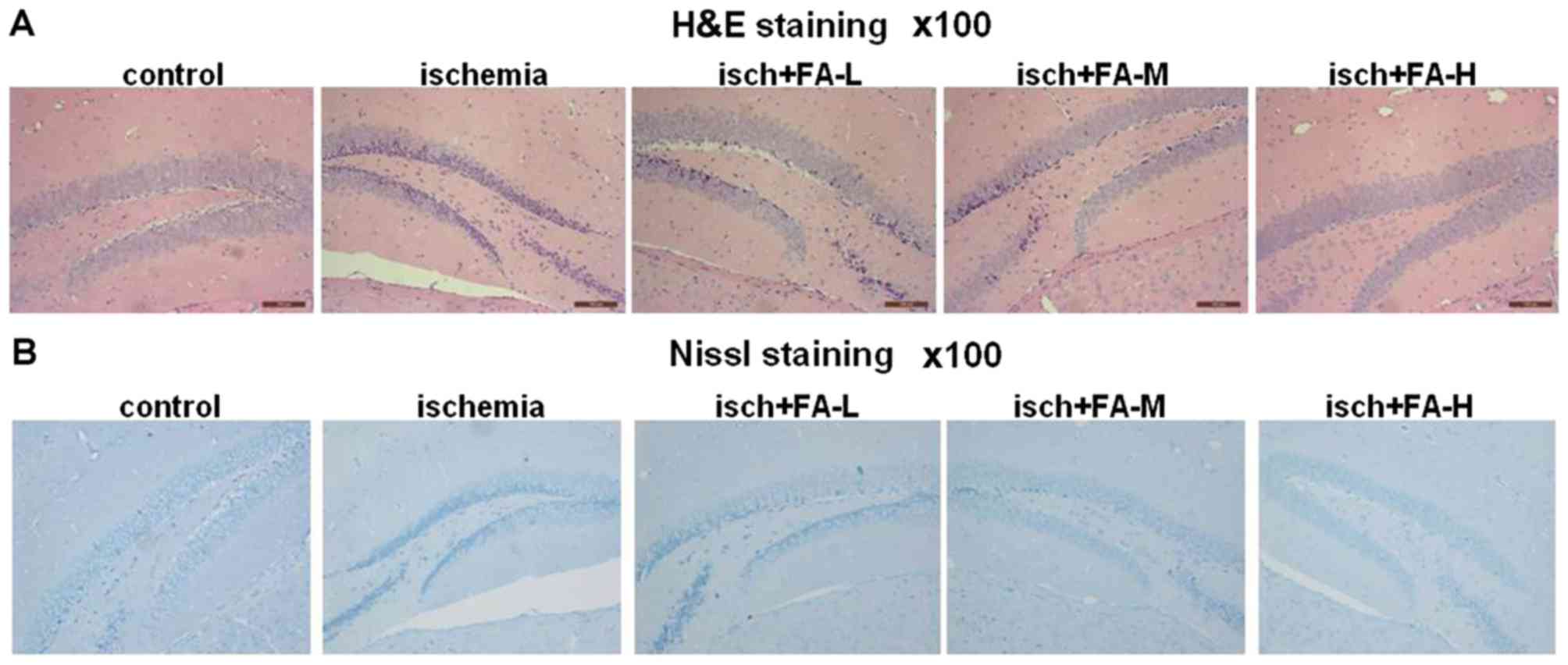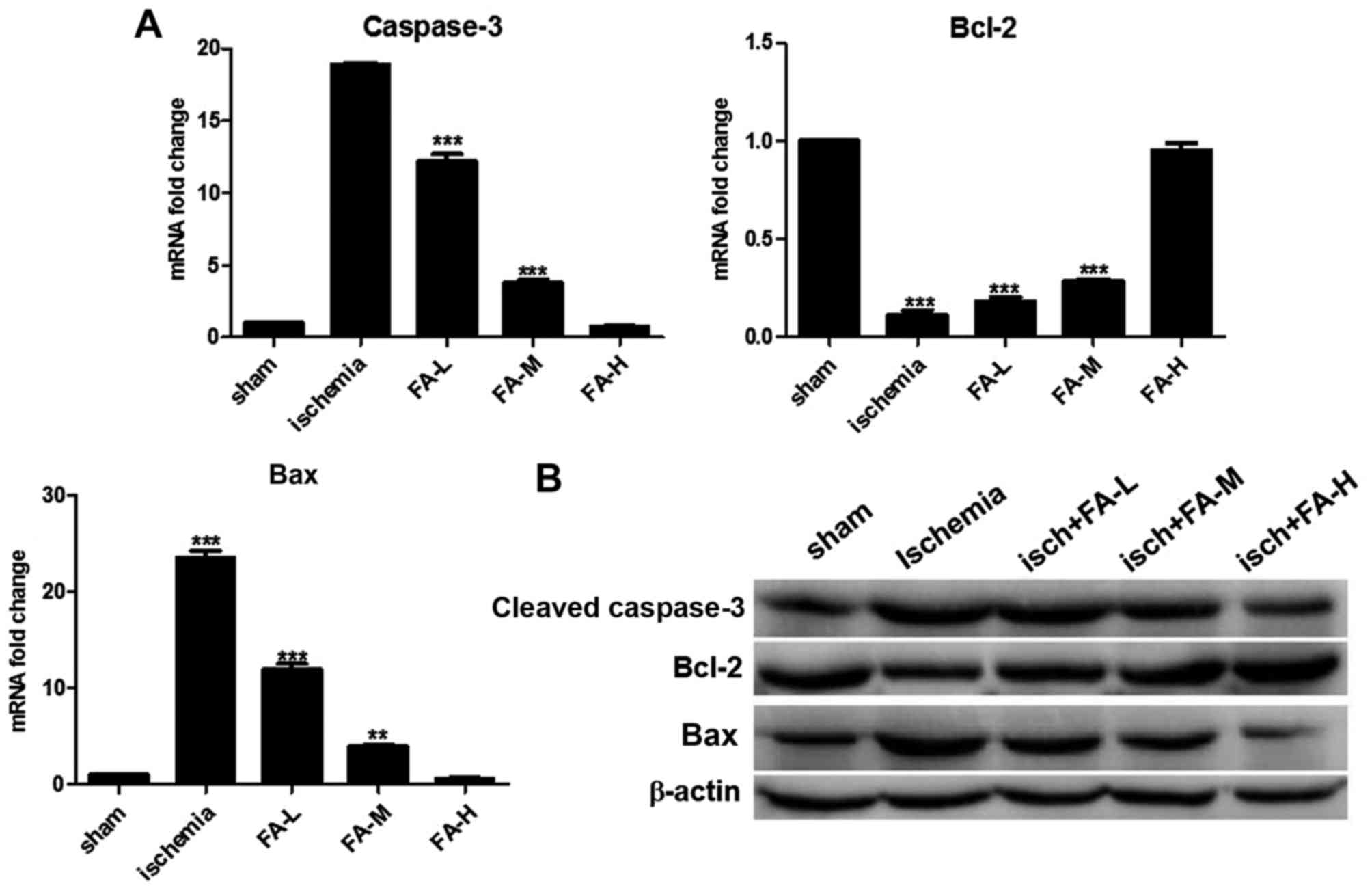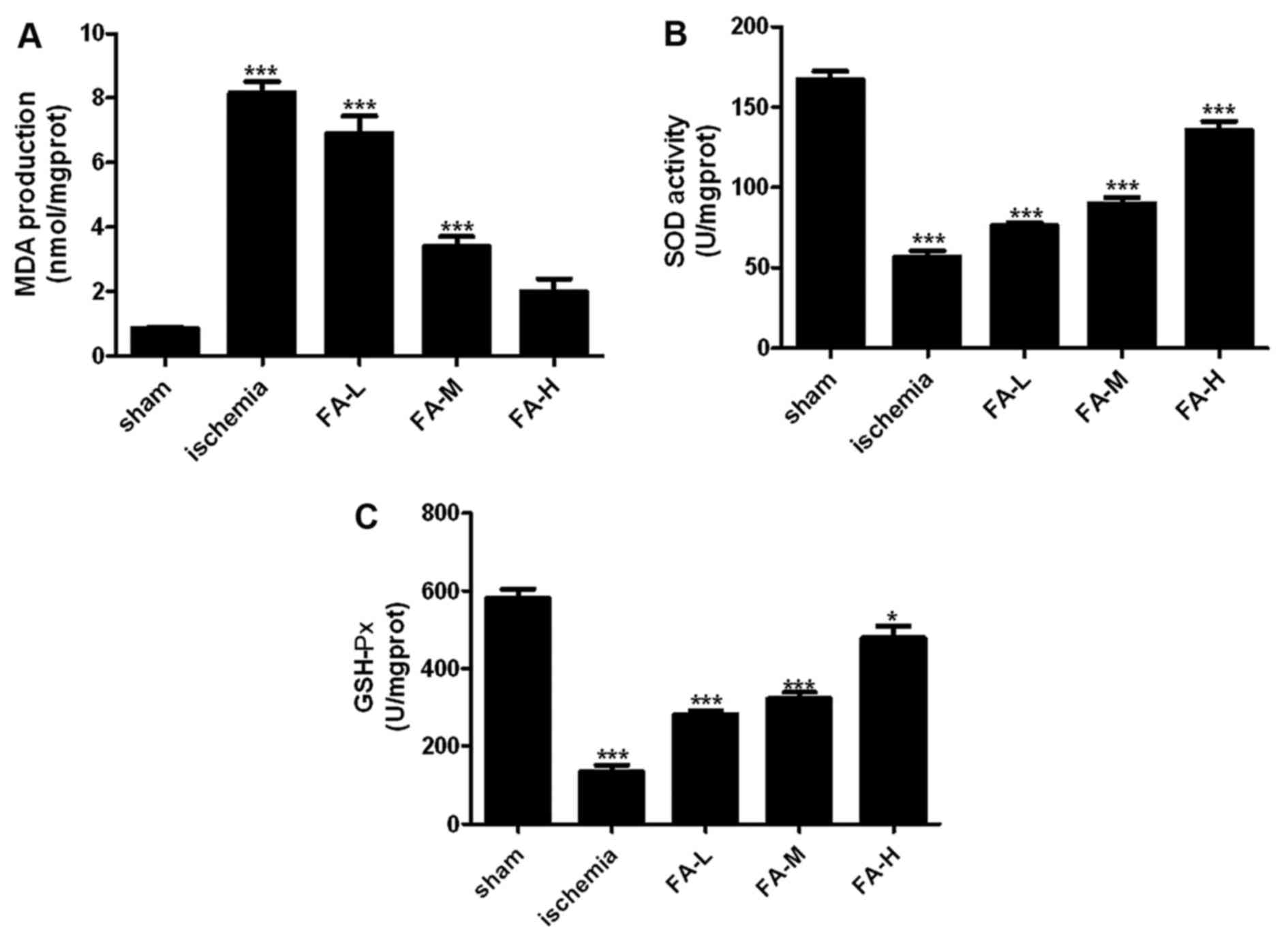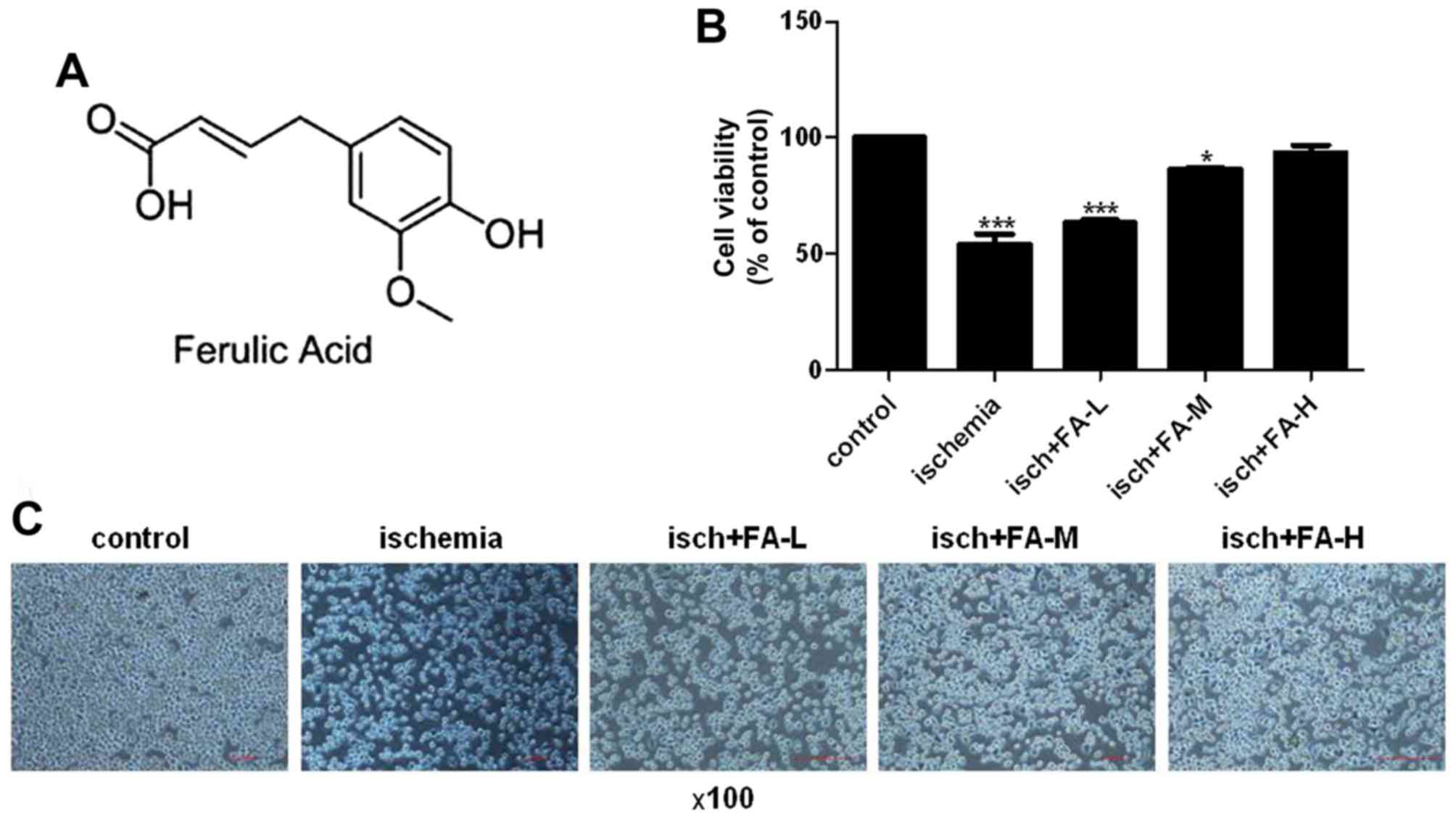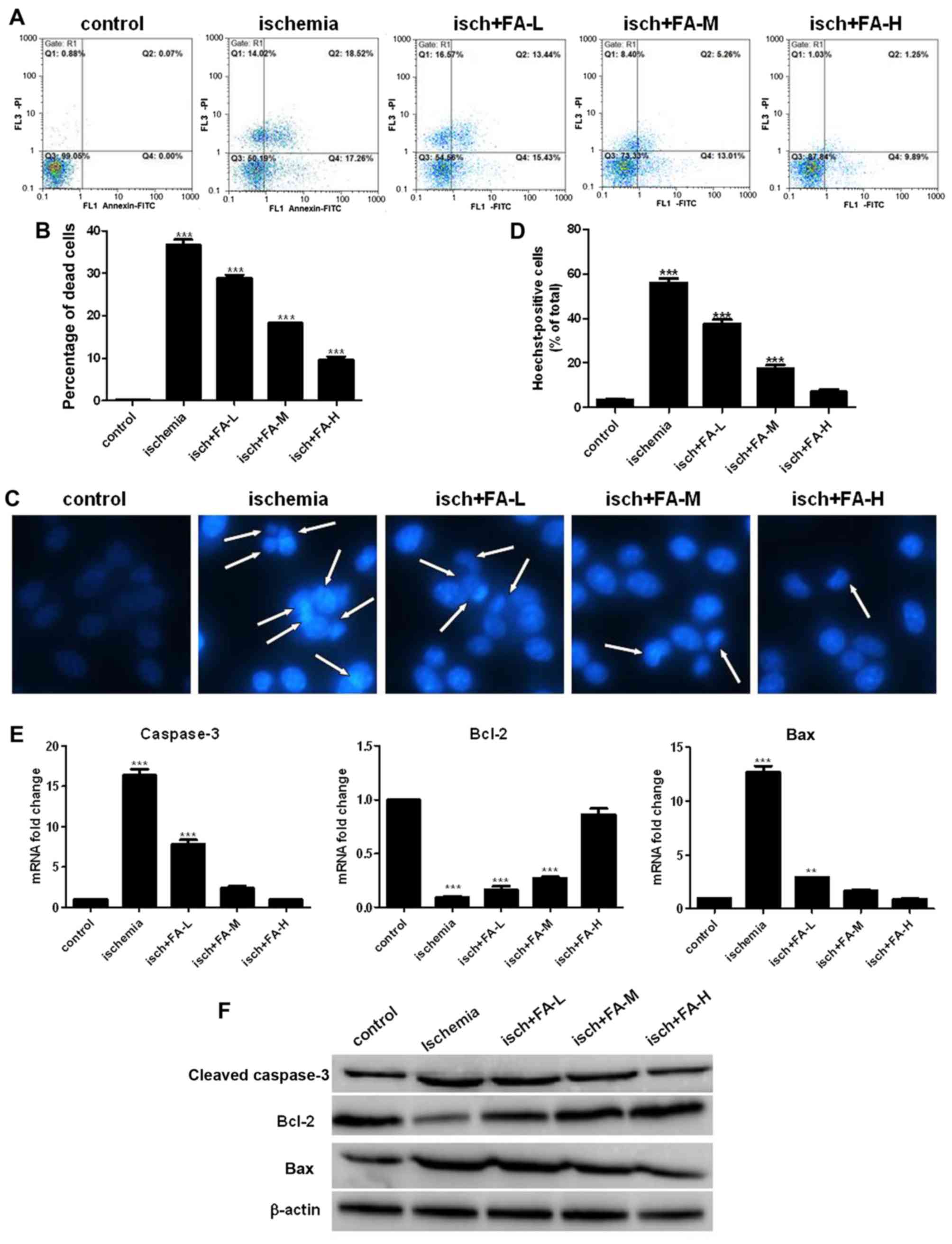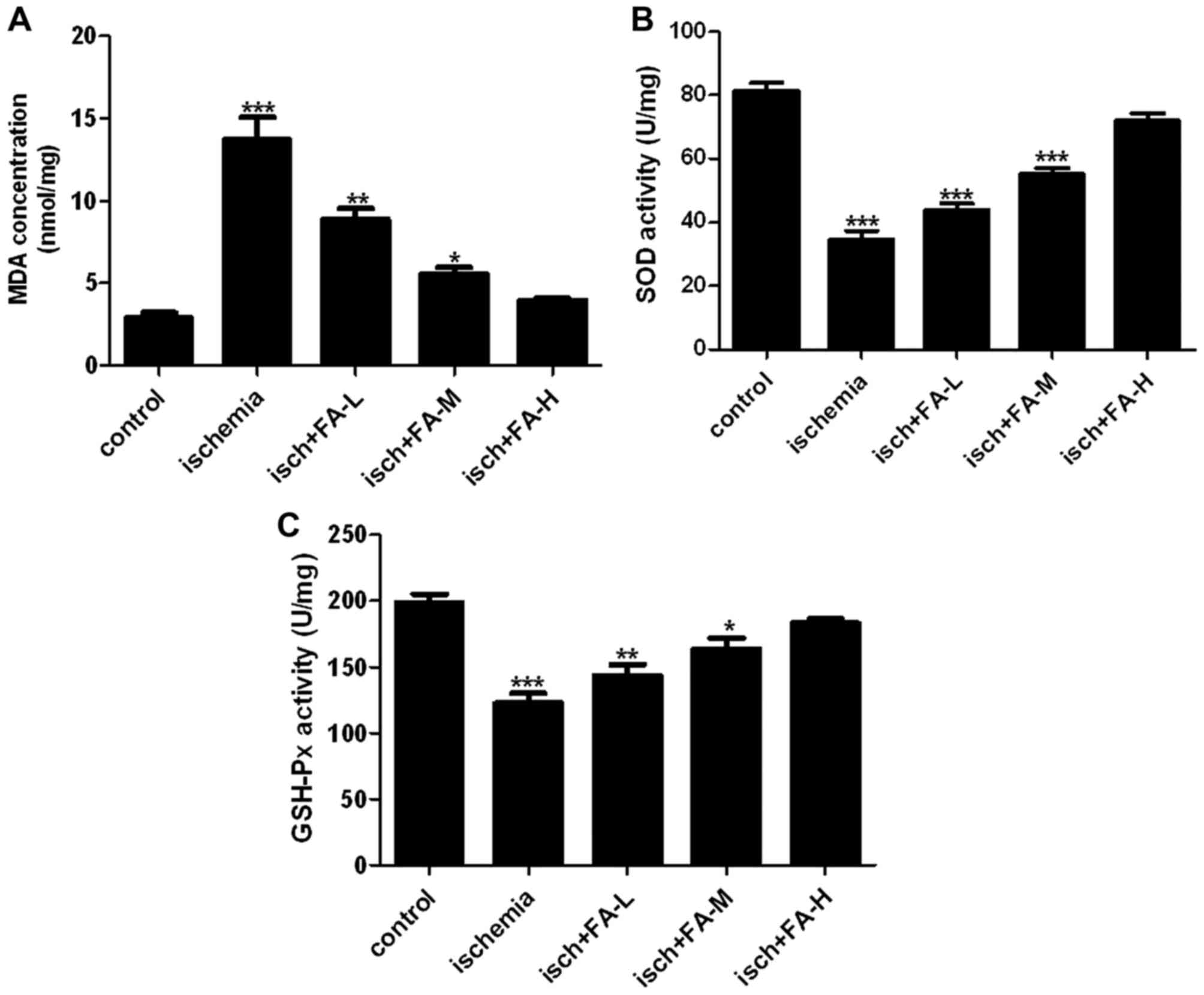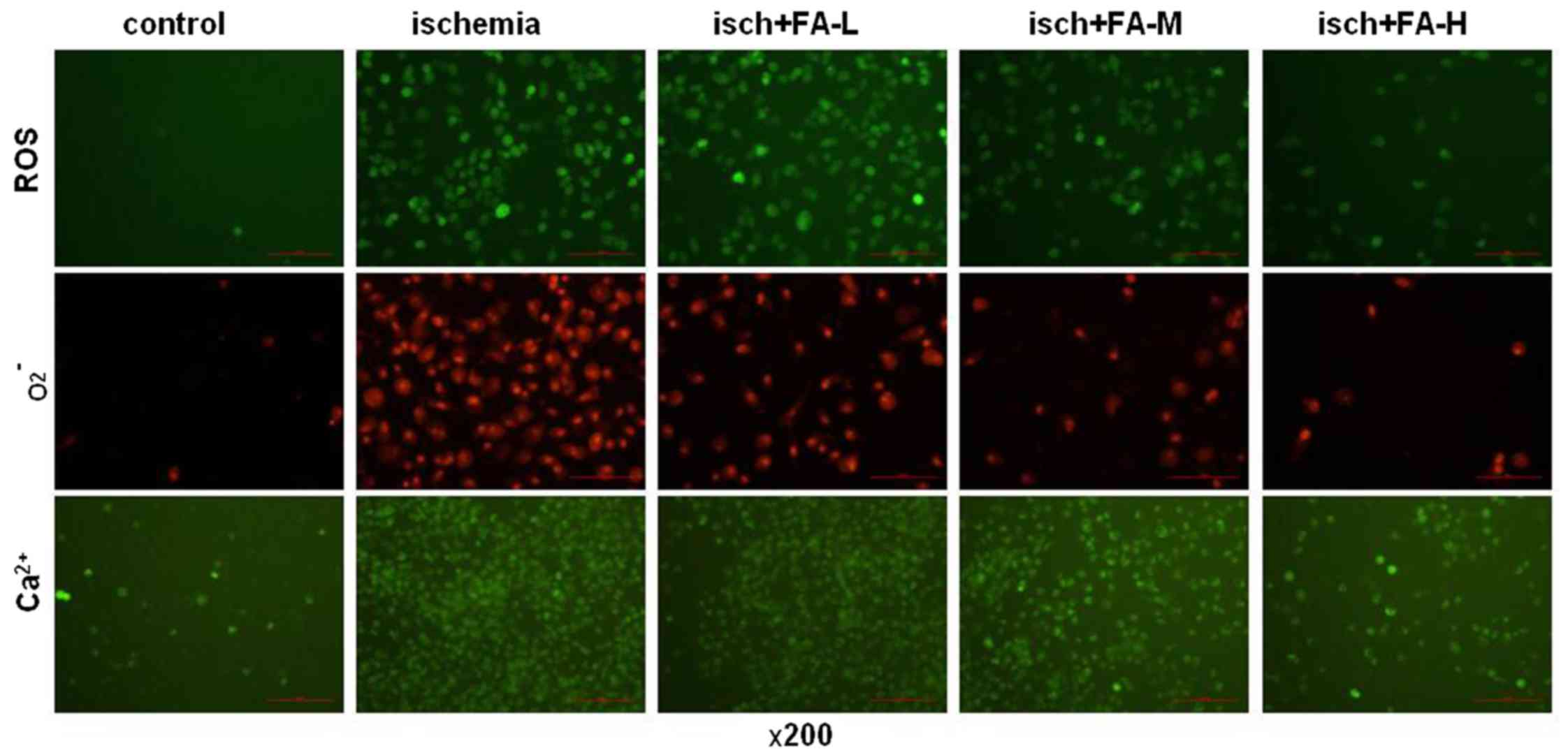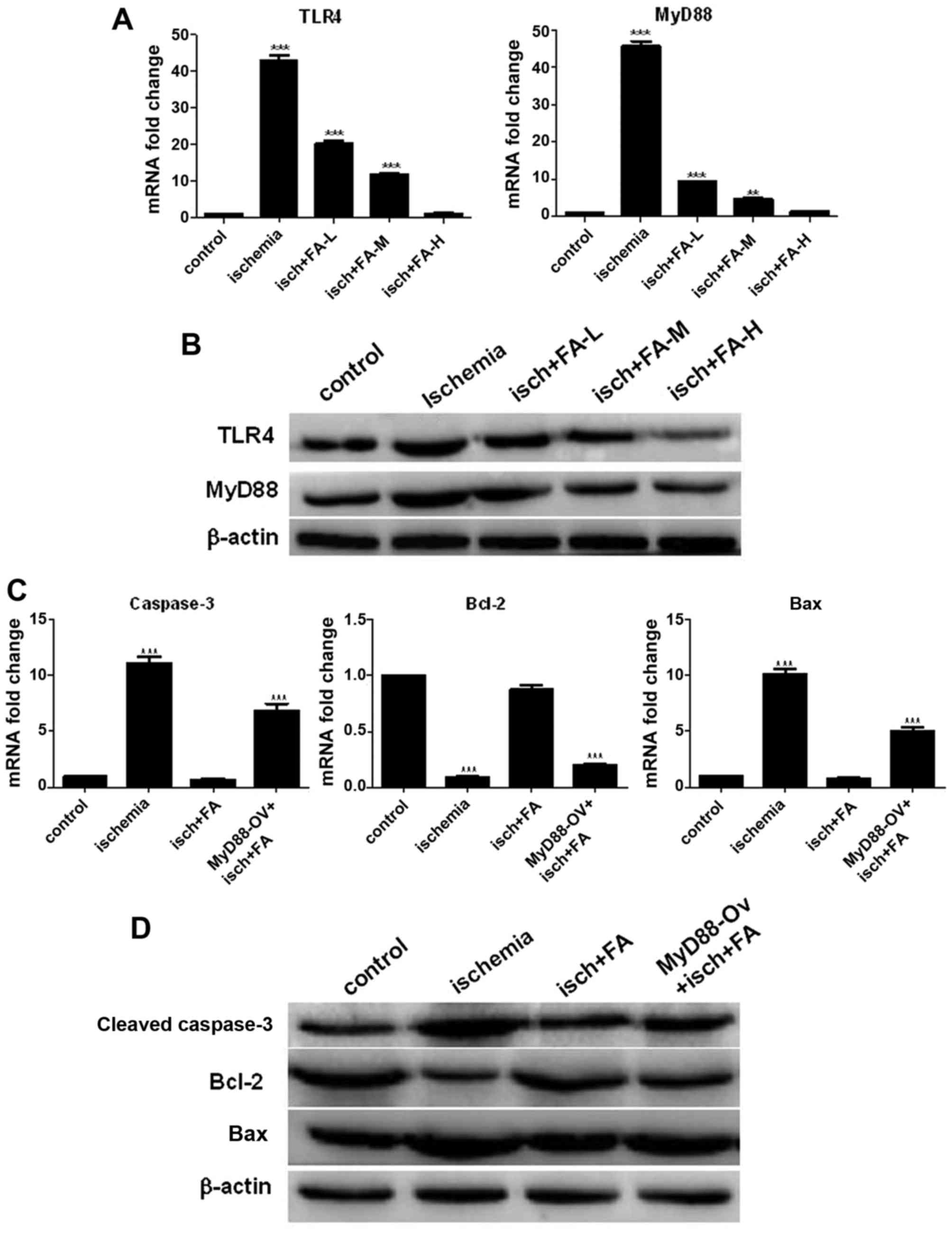|
1
|
Srinivasan M, Sudheer AR, Pillai KR, Kumar
PR, Sudhakaran PR and Menon VP: Influence of ferulic acid on
gamma-radiation induced DNA damage, lipid peroxidation and
antioxidant status in primary culture of isolated rat hepatocytes.
Toxicology. 228:249–258. 2006. View Article : Google Scholar : PubMed/NCBI
|
|
2
|
Srinivasan M, Sudheer AR and Menon VP:
Ferulic Acid: Therapeutic potential through its antioxidant
property. J Clin Biochem Nutr. 40:92–100. 2007. View Article : Google Scholar
|
|
3
|
Ogiwara T, Satoh K, Kadoma Y, Murakami Y,
Unten S, Atsumi T, Sakagami H and Fujisawa S: Radical scavenging
activity and cytotoxicity of ferulic acid. Anticancer Res.
22:2711–2717. 2002.
|
|
4
|
Hong Q, Ma ZC, Huang H, Wang YG, Tan HL,
Xiao CR, Liang QD, Zhang HT and Gao Y: Antithrombotic activities of
ferulic acid via intracellular cyclic nucleotide signaling. Eur J
Pharmacol. 777:1–8. 2016. View Article : Google Scholar : PubMed/NCBI
|
|
5
|
Jin Son M, W Rico C, Hyun Nam S and Young
Kang M: Influence of oryzanol and ferulic acid on the lipid
metabolism and antioxidative status in high fat-fed mice. J Clin
Biochem Nutr. 46:150–156. 2010. View Article : Google Scholar : PubMed/NCBI
|
|
6
|
Lo HH and Chung JG: The effects of plant
phenolics, caffeic acid, chlorogenic acid and ferulic acid on
arylamine N-acetyltransferase activities in human gastrointestinal
microflora. Anticancer Res. 19:133–139. 1999.PubMed/NCBI
|
|
7
|
Ichimura T, Otake T, Mori H and Maruyama
S: HIV-1 protease inhibition and anti-HIV effect of natural and
synthetic water-soluble lignin-like substances. Biosci Biotechnol
Biochem. 63:2202–2204. 1999. View Article : Google Scholar
|
|
8
|
Kawabata K, Yamamoto T, Hara A, Shimizu M,
Yamada Y, Matsunaga K, Tanaka T and Mori H: Modifying effects of
ferulic acid on azoxymethane-induced colon carcinogenesis in F344
rats. Cancer Lett. 157:15–21. 2000. View Article : Google Scholar : PubMed/NCBI
|
|
9
|
Yogeeta SK, Hanumantra RB, Gnanapragasam
A, Senthilkumar S, Subhashini R and Devaki T: Attenuation of
abnormalities in the lipid metabolism during experimental
myocardial infarction induced by isoproterenol in rats: beneficial
effect of ferulic acid and ascorbic acid. Basic Clin Pharmacol
Toxicol. 98:467–472. 2006. View Article : Google Scholar : PubMed/NCBI
|
|
10
|
Cheng CY, Ho TY, Lee EJ, Su SY, Tang NY
and Hsieh CL: Ferulic acid reduces cerebral infarct through its
antioxidative and anti-inflammatory effects following transient
focal cerebral ischemia in rats. Am J Chin Med. 36:1105–1119. 2008.
View Article : Google Scholar : PubMed/NCBI
|
|
11
|
Kalogeris T, Baines CP, Krenz M and
Korthuis RJ: Cell biology of ischemia/reperfusion injury. Int Rev
Cell Mol Biol. 298:229–317. 2012. View Article : Google Scholar : PubMed/NCBI
|
|
12
|
Pei Z, Ho HT and Cheung RT: Pre-treatment
with melatonin reduces volume of cerebral infarction in a permanent
middle cerebral artery occlusion stroke model in the rat. Neurosci
Lett. 318:141–144. 2002. View Article : Google Scholar : PubMed/NCBI
|
|
13
|
Simerabet M, Robin E, Aristi I, Adamczyk
S, Tavernier B, Vallet B, Bordet R and Lebuffe G: Preconditioning
by an in situ administration of hydrogen peroxide: Involvement of
reactive oxygen species and mitochondrial ATP-dependent potassium
channel in a cerebral ischemia-reperfusion model. Brain Res.
1240:177–184. 2008. View Article : Google Scholar : PubMed/NCBI
|
|
14
|
Cao LJ, Wang J, Hao PP, Sun CL and Chen
YG: Effects of ulinastatin, a urinary trypsin inhibitor, on
synaptic plasticity and spatial memory in a rat model of cerebral
ischemia/reperfusion injury. Chin J Physiol. 54:435–442. 2011.
|
|
15
|
Feng X, Yang S, Liu J, Huang J, Peng J,
Lin J, Tao J and Chen L: Electroacupuncture ameliorates cognitive
impairment through inhibition of NF-κB-mediated neuronal cell
apoptosis in cerebral ischemia-reperfusion injured rats. Mol Med
Rep. 7:1516–1522. 2013. View Article : Google Scholar : PubMed/NCBI
|
|
16
|
Wu YY, Wu WY, Gong HL, Li WZ and Yin YY:
Astragalosides attenuate learning and memory impairment in rats
following ischemia reperfusion injury. Mol Med Rep. 9:1319–1324.
2014. View Article : Google Scholar : PubMed/NCBI
|
|
17
|
Kuo CT, Lin YW, Tang NY, Cheng CY and
Hsieh CL: Electric stimulation of the ears ameliorated learning and
memory impairment in rats with cerebral ischemia-reperfusion
injury. Sci Rep. 6:203812016. View Article : Google Scholar : PubMed/NCBI
|
|
18
|
Liu Y, Zhang L and Liang J: Activation of
the Nrf2 defense pathway contributes to neuroprotective effects of
phloretin on oxidative stress injury after cerebral
ischemia/reperfusion in rats. J Neurol Sci. 351:88–92. 2015.
View Article : Google Scholar : PubMed/NCBI
|
|
19
|
Schimidt HL, Vieira A, Altermann C,
Martins A, Sosa P, Santos FW, Mello-Carpes PB, Izquierdo I and
Carpes FP: Memory deficits and oxidative stress in cerebral
ischemia-reperfusion: neuroprotective role of physical exercise and
green tea supplementation. Neurobiol Learn Mem. 114:242–250. 2014.
View Article : Google Scholar : PubMed/NCBI
|
|
20
|
Ishikawa M, Zhang JH, Nanda A and Granger
DN: Inflammatory responses to ischemia and reperfusion in the
cerebral microcirculation. Front Biosci. 9:1339–1347. 2004.
View Article : Google Scholar : PubMed/NCBI
|
|
21
|
Chen B, Wu Z, Xu J and Xu Y: Calreticulin
binds to Fas ligand and inhibits neuronal cell apoptosis induced by
ischemia-reperfusion injury. Biomed Res Int. 2015:8952842015.
View Article : Google Scholar : PubMed/NCBI
|
|
22
|
Mehta SL, Manhas N and Raghubir R:
Molecular targets in cerebral ischemia for developing novel
therapeutics. Brain Res Brain Res Rev. 54:34–66. 2007. View Article : Google Scholar
|
|
23
|
Lewén A, Matz P and Chan PH: Free radical
pathways in CNS injury. J Neurotrauma. 17:871–890. 2000. View Article : Google Scholar : PubMed/NCBI
|
|
24
|
Tabakman R, Jiang H, Shahar I, Arien-Zakay
H, Levine RA and Lazarovici P: Neuroprotection by NGF in the PC12
in vitro OGD model: Involvement of mitogen-activated protein
kinases and gene expression. Ann NY Acad Sci. 1053:84–96. 2005.
View Article : Google Scholar : PubMed/NCBI
|
|
25
|
Nunes C, Almeida L and Laranjinha J:
3,4-Dihydroxyphenylacetic acid (DOPAC) modulates the toxicity
induced by nitric oxide in PC-12 cells via mitochondrial
dysfunctioning. Neurotoxicology. 29:998–1007. 2008. View Article : Google Scholar : PubMed/NCBI
|
|
26
|
Zhang Y and Bhavnani BR: Glutamate-induced
apoptosis in primary cortical neurons is inhibited by equine
estrogens via down-regulation of caspase-3 and prevention of
mitochondrial cytochrome c release. BMC Neurosci. 6:132005.
View Article : Google Scholar : PubMed/NCBI
|
|
27
|
Niizuma K, Endo H and Chan PH: Oxidative
stress and mitochondrial dysfunction as determinants of ischemic
neuronal death and survival. J Neurochem. 109(Suppl 1): 133–138.
2009. View Article : Google Scholar : PubMed/NCBI
|
|
28
|
Susnow N, Zeng L, Margineantu D and
Hockenbery DM: Bcl-2 family proteins as regulators of oxidative
stress. Semin Cancer Biol. 19:42–49. 2009. View Article : Google Scholar : PubMed/NCBI
|
|
29
|
Zhu L, Wei T, Gao J, Chang X, He H, Luo F,
Zhou R, Ma C, Liu Y and Yan T: The cardioprotective effect of
salidroside against myocardial ischemia reperfusion injury in rats
by inhibiting apoptosis and inflammation. Apoptosis. 20:1433–1443.
2015. View Article : Google Scholar : PubMed/NCBI
|
|
30
|
Hu J, Zhu XH, Zhang XJ, Wang PX, Zhang R,
Zhang P, Zhao GN, Gao L, Zhang XF, Tian S, et al: Targeting TRAF3
signaling protects against hepatic ischemia/reperfusions injury. J
Hepatol. 64:146–159. 2016. View Article : Google Scholar
|
|
31
|
Zaidi A, Fernandes D, Bean JL and
Michaelis ML: Effects of paraquat-induced oxidative stress on the
neuronal plasma membrane Ca(2+)-ATPase. Free Radic Biol Med.
47:1507–1514. 2009. View Article : Google Scholar : PubMed/NCBI
|
|
32
|
Kizmazoglu C, Aydin HE, Sevin IE, Kalemci
O, Yüceer N and Atasoy MA: Neuroprotective effect of resveratrol on
acute brain ischemia reperfusion injury by measuring Annexin V,
p53, Bcl-2 levels in rats. J Korean Neurosurg Soc. 58:508–512.
2015. View Article : Google Scholar
|
|
33
|
Kanski J, Aksenova M, Stoyanova A and
Butterfield DA: Ferulic acid antioxidant protection against
hydroxyl and peroxyl radical oxidation in synaptosomal and neuronal
cell culture systems in vitro: Structure-activity studies. J Nutr
Biochem. 13:273–281. 2002. View Article : Google Scholar : PubMed/NCBI
|
|
34
|
Kikuzaki H, Hisamoto M, Hirose K, Akiyama
K and Taniguchi H: Antioxidant properties of ferulic acid and its
related compounds. J Agric Food Chem. 50:2161–2168. 2002.
View Article : Google Scholar : PubMed/NCBI
|
|
35
|
Aderem A and Ulevitch RJ: Toll-like
receptors in the induction of the innate immune response. Nature.
406:782–787. 2000. View Article : Google Scholar : PubMed/NCBI
|
|
36
|
Caso JR, Pradillo JM, Hurtado O, Lorenzo
P, Moro MA and Lizasoain I: Toll-like receptor 4 is involved in
brain damage and inflammation after experimental stroke.
Circulation. 115:1599–1608. 2007. View Article : Google Scholar : PubMed/NCBI
|
|
37
|
Oyama J, Blais C Jr, Liu X, Pu M, Kobzik
L, Kelly RA and Bourcier T: Reduced myocardial ischemia-reperfusion
injury in Toll-like receptor 4-deficient mice. Circulation.
109:784–789. 2004. View Article : Google Scholar : PubMed/NCBI
|
|
38
|
Sakata Y, Dong JW, Vallejo JG, Huang CH,
Baker JS, Tracey KJ, Tacheuchi O, Akira S and Mann DL: Toll-like
receptor 2 modulates left ventricular function following
ischemia-reperfusion injury. Am J Physiol Heart Circ Physiol.
292:H503–H509. 2007. View Article : Google Scholar
|
|
39
|
Wu H, Chen G, Wyburn KR, Yin J, Bertolino
P, Eris JM, Alexander SI, Sharland AF and Chadban SJ: TLR4
activation mediates kidney ischemia/reperfusion injury. J Clin
Invest. 117:2847–2859. 2007. View Article : Google Scholar : PubMed/NCBI
|
|
40
|
Chen LW, Chang WJ, Chen PH, Liu WC and Hsu
CM: TLR ligand decreases mesenteric ischemia and reperfusion
injury-induced gut damage through TNF-alpha signaling. Shock.
30:563–570. 2008. View Article : Google Scholar : PubMed/NCBI
|
|
41
|
Zhai Y, Shen XD, O'Connell R, Gao F,
Lassman C, Busuttil RW, Cheng G and Kupiec-Weglinski JW: Cutting
edge: TLR4 activation mediates liver ischemia/reperfusion
inflammatory response via IFN regulatory factor 3-dependent
MyD88-independent pathway. J Immunol. 173:7115–7119. 2004.
View Article : Google Scholar : PubMed/NCBI
|
|
42
|
Altemeier WA, Liles WC, Villagra-Garcia A,
Matute-Bello G and Glenny RW: Ischemia-reperfusion lung injury is
attenuated in MyD88-deficient mice. PLoS One. 8:e771232013.
View Article : Google Scholar : PubMed/NCBI
|
|
43
|
Ye X, Kong D, Wang J, Ishrat T, Shi H,
Ding X, Cui G and Hua F: MyD88 contributes to neuroinflammatory
responses induced by cerebral ischemia/reperfusion in mice. Biochem
Biophys Res Commun. 480:69–74. 2016. View Article : Google Scholar : PubMed/NCBI
|
|
44
|
Van Meer P and Raber J: Mouse behavioural
analysis in systems biology. Biochem J. 389:593–610. 2005.
View Article : Google Scholar : PubMed/NCBI
|
|
45
|
Morris RG, Garrud P, Rawlins JN and
O'Keefe J: Place navigation impaired in rats with hippocampal
lesions. Nature. 297:681–683. 1982. View Article : Google Scholar : PubMed/NCBI
|
|
46
|
Cao YJ, He X, Wang N and He LC: Effects of
imperatorin, the active component from Radix Angelicae (Baizhi), on
the blood pressure and oxidative stress in 2K,1C hypertensive rats.
Phytomedicine. 20:1048–1054. 2013. View Article : Google Scholar : PubMed/NCBI
|
|
47
|
Dong Y, Yang N, Liu Y, Li Q and Zuo P: The
neuroprotective effects of phytoestrogen α-zearalanol on
β-amyloid-induced toxicity in differentiated PC-12 cells. Eur J
Pharmacol. 670:392–398. 2011. View Article : Google Scholar : PubMed/NCBI
|
|
48
|
Kazmierczak A, Strosznajder JB and
Adamczyk A: Alpha-synuclein enhances secretion and toxicity of
amyloid beta peptides in PC12 cells. Neurochem Int. 53:263–269.
2008. View Article : Google Scholar : PubMed/NCBI
|
|
49
|
Tamnes CK, Walhovd KB, Engvig A, Grydeland
H, Krogsrud SK, Østby Y, Holland D, Dale AM and Fjell AM: Regional
hippocampal volumes and development predict learning and memory.
Dev Neurosci. 36:161–174. 2014. View Article : Google Scholar : PubMed/NCBI
|
|
50
|
Dagher PC: Apoptosis in ischemic renal
injury: roles of GTP depletion and p53. Kidney Int. 66:506–509.
2004. View Article : Google Scholar : PubMed/NCBI
|
|
51
|
Niu YL, Li C and Zhang GY: Blocking Daxx
trafficking attenuates neuronal cell death following
ischemia/reperfusion in rat hippocampus CA1 region. Arch Biochem
Biophys. 515:89–98. 2011. View Article : Google Scholar : PubMed/NCBI
|
|
52
|
Bae EJ, Chen BH, Yan BC, Shin BN, Cho JH,
Kim IH, Ahn JH, Lee JC, Tae HJ, Hong S, et al: Delayed hippocampal
neuronal death in young gerbil following transient global cerebral
ischemia is related to higher and longer-term expression of p63 in
the ischemic hippocampus. Neural Regen Res. 10:944–950. 2015.
View Article : Google Scholar : PubMed/NCBI
|
|
53
|
Erfani S, Khaksari M, Oryan S, Shamsaei N,
Aboutaleb N, Nikbakht F, Jamali-Raeufy N and Gorjipour F: Visfatin
reduces hippocampal CA1 cells death and improves learning and
memory deficits after transient global ischemia/reperfusion.
Neuropeptides. 49:63–68. 2015. View Article : Google Scholar : PubMed/NCBI
|
|
54
|
Leão AH, Medeiros AM, Apolinário GK,
Cabral A, Ribeiro AM, Barbosa FF and Silva RH:
Hippocampal-dependent memory in the plus-maze discriminative
avoidance task: The role of spatial cues and CA1 activity. Behav
Brain Res. 304:24–33. 2016. View Article : Google Scholar : PubMed/NCBI
|
|
55
|
Bird CM and Burgess N: The hippocampus and
memory: Insights from spatial processing. Nat Rev Neurosci.
9:182–194. 2008. View Article : Google Scholar : PubMed/NCBI
|
|
56
|
Arda-Pirincci P and Bolkent S: The role of
epidermal growth factor in prevention of oxidative injury and
apoptosis induced by intestinal ischemia/reperfusion in rats. Acta
Histochem. 116:167–75. 2014. View Article : Google Scholar
|
|
57
|
Nakashima M, Niwa M, Iwai T and Uematsu T:
Involvement of free radicals in cerebral vascular reperfusion
injury evaluated in a transient focal cerebral ischemia model of
rat. Free Radic Biol Med. 26:722–729. 1999. View Article : Google Scholar : PubMed/NCBI
|
|
58
|
Rodrigo J, Fernández AP, Serrano J,
Peinado MA and Martínez A: The role of free radicals in cerebral
hypoxia and ischemia. Free Radic Biol Med. 39:26–50. 2005.
View Article : Google Scholar : PubMed/NCBI
|
|
59
|
He F, Ye B, Chen J, Sun X and Li C:
Influence of hepatocyte growth factor on iNOS, NO and IL-1β in the
cerebrum during cerebral ischemia/reperfusion in rats. Zhong Nan Da
Xue Xue Bao Yi Xue Ban. 39:23–9. 2014.In Chinese. PubMed/NCBI
|
|
60
|
Szydlowska K and Tymianski M: Calcium,
ischemia and excitotoxicity. Cell Calcium. 47:122–129. 2010.
View Article : Google Scholar : PubMed/NCBI
|
|
61
|
Pradeep H, Diya JB, Shashikumar S and
Rajanikant GK: Oxidative stress - assassin behind the ischemic
stroke. Folia Neuropathol. 50:219–230. 2012. View Article : Google Scholar
|
|
62
|
Liu L, Sun Q, Wang R, Chen Z, Wu J, Xia F
and Fan XQ: Methane attenuates retinal ischemia/reperfusion injury
via anti-oxidative and anti-apoptotic pathways. Brain Res.
1646:327–333. 2016. View Article : Google Scholar : PubMed/NCBI
|
|
63
|
Wang X, Zhou H and Yang J: GSH.Px or SOD
encapsulated erythrocytes in the study of cerebral
ischemia-reperfusion. Zhonghua Yi Xue Za Zhi. 77:43–46. 1997.In
Chinese. PubMed/NCBI
|
|
64
|
Wang TF, Lei Z, Li YX, Wang YS, Wang J,
Wang SJ, Hao YJ, Zhou R, Jin SJ, Du J, et al: Oxysophoridine
protects against focal cerebral ischemic injury by inhibiting
oxidative stress and apoptosis in mice. Neurochem Res.
38:2408–2417. 2013. View Article : Google Scholar : PubMed/NCBI
|
|
65
|
Zhang RQ, Li DY, Xu TD, Zhu SS, Pan HJ,
Fang F, Wu X and Sun H: Antioxidative effect of luteolin
pretreatment on simulated ischemia/reperfusion injury in
cardiomyocyte and perfused rat heart. Chin J Integr Med. Mar
8–2016.Epub ahead of print.
|
|
66
|
Chandra Jagetia G, Rajanikant GK, Rao SK
and Shrinath Baliga M: Alteration in the glutathione, glutathione
peroxidase, superoxide dismutase and lipid peroxidation by ascorbic
acid in the skin of mice exposed to fractionated gamma radiation.
Clin Chim Acta. 332:111–121. 2003. View Article : Google Scholar : PubMed/NCBI
|
|
67
|
Tu Q, Wang R, Ding B, Zhong W and Cao H:
Protective and antioxidant effect of Danshen polysaccharides on
cerebral ischemia/reperfusion injury in rats. Int J Biol Macromol.
60:268–271. 2013. View Article : Google Scholar : PubMed/NCBI
|
|
68
|
Negis Y, Unal AY, Korulu S and Karabay A:
Cell cycle markers have different expression and localization
patterns in neuron-like PC12 cells and primary hippocampal neurons.
Neurosci Lett. 496:135–140. 2011. View Article : Google Scholar : PubMed/NCBI
|
|
69
|
Yamazaki M, Chiba K and Mohri T:
Differences in neuritogenic response to nitric oxide in PC12 and
PC12h cells. Neurosci Lett. 393:222–225. 2006. View Article : Google Scholar
|
|
70
|
Zhang ZG, Lü TS and Yuan HY:
Neuroprotective effects of ultra-low-molecular-weight heparin in
vitro and in vivo models of ischemic injury. Fundam Clin Pharmacol.
25:300–303. 2011. View Article : Google Scholar
|
|
71
|
Tsung A, Sahai R, Tanaka H, Nakao A, Fink
MP, Lotze MT, Yang H, Li J, Tracey KJ, Geller DA, et al: The
nuclear factor HMGB1 mediates hepatic injury after murine liver
ischemia-reperfusion. JExp Med. 201:1135–1143. 2005. View Article : Google Scholar
|
|
72
|
Wang L, Zhang X, Liu L, Cui L, Yang R, Li
M and Du W: Tanshinone II A down-regulates HMGB1, RAGE, TLR4,
NF-kappaB expression, ameliorates BBB permeability and endothelial
cell function, and protects rat brains against focal ischemia.
Brain Res. 1321:143–151. 2010. View Article : Google Scholar : PubMed/NCBI
|
|
73
|
Iwasaki A and Medzhitov R: Toll-like
receptor control of the adaptive immune responses. Nat Immunol.
5:987–995. 2004. View
Article : Google Scholar : PubMed/NCBI
|
|
74
|
Cheng CY, Su SY, Tang NY, Ho TY, Chiang SY
and Hsieh CL: Ferulic acid provides neuroprotection against
oxidative stress-related apoptosis after cerebral
ischemia/reperfusion injury by inhibiting ICAM-1 mRNA expression in
rats. Brain Res. 1209:136–150. 2008. View Article : Google Scholar : PubMed/NCBI
|



